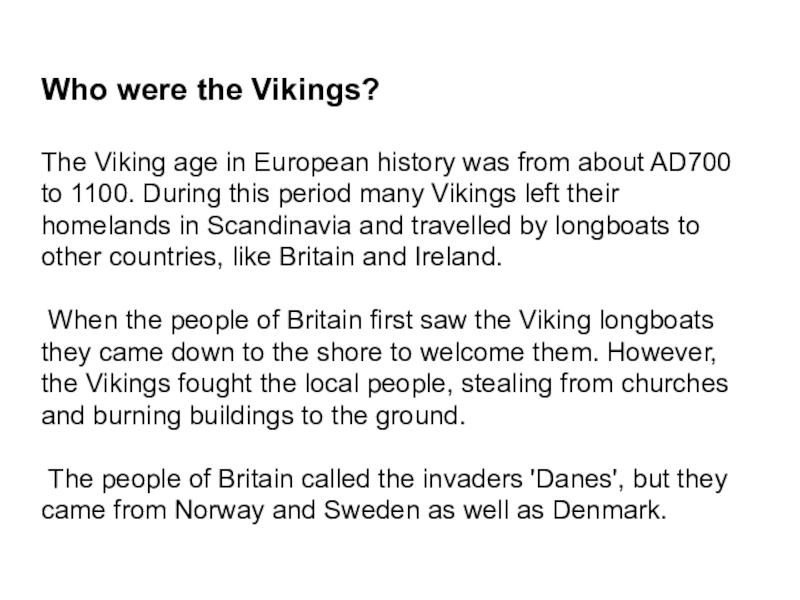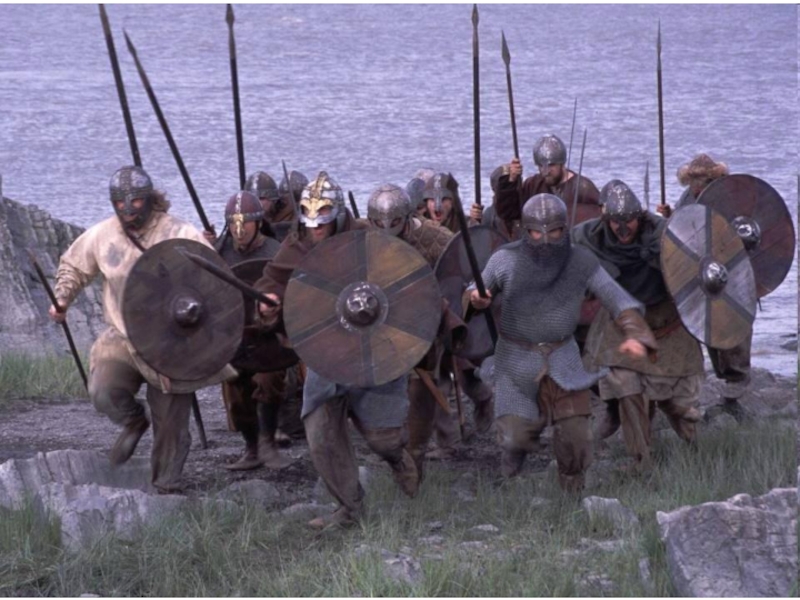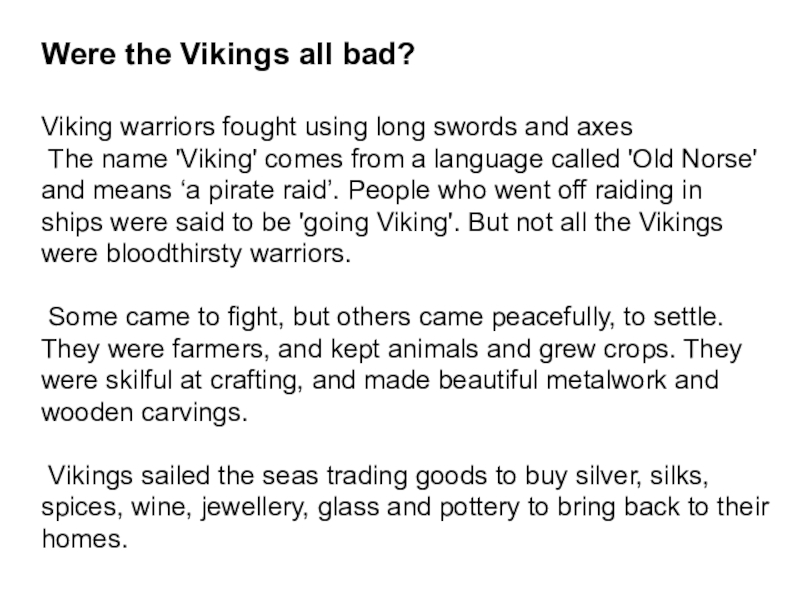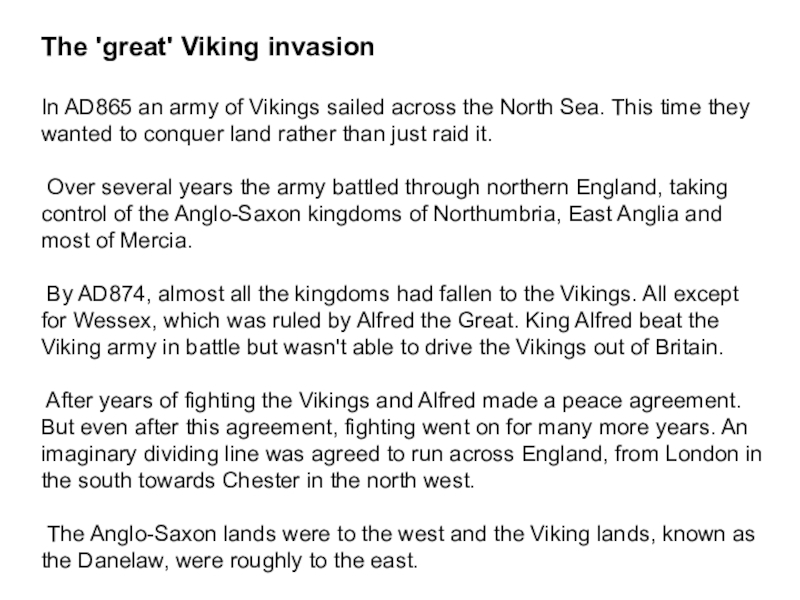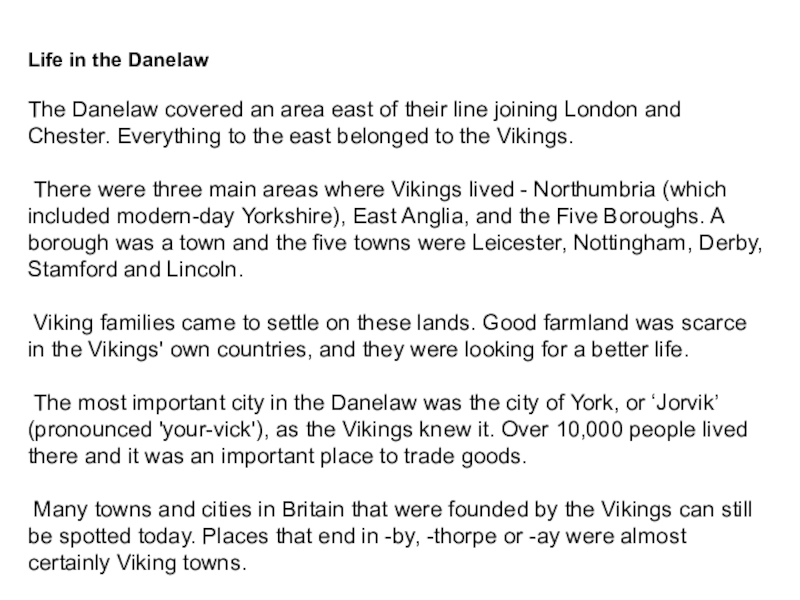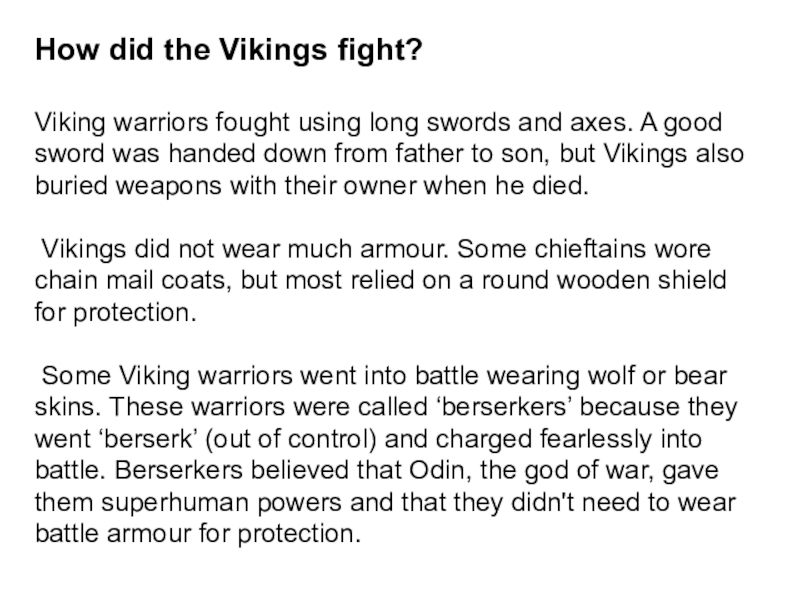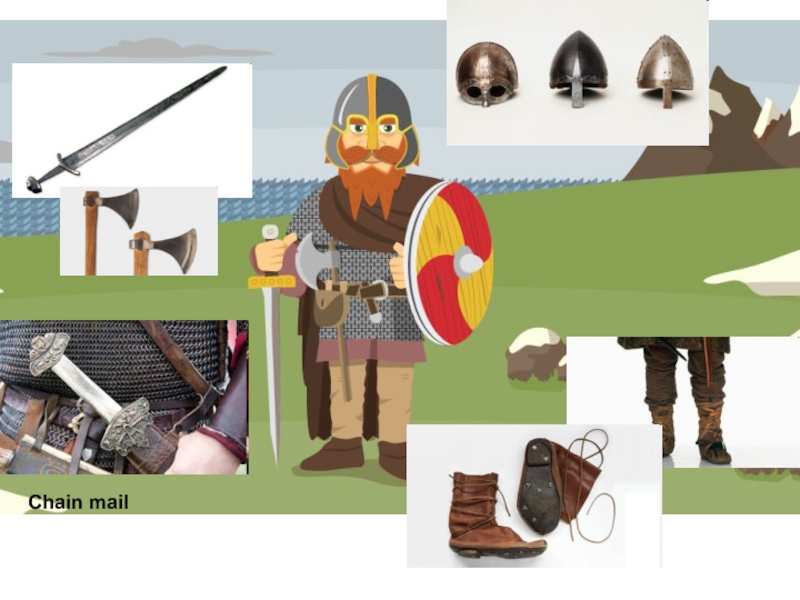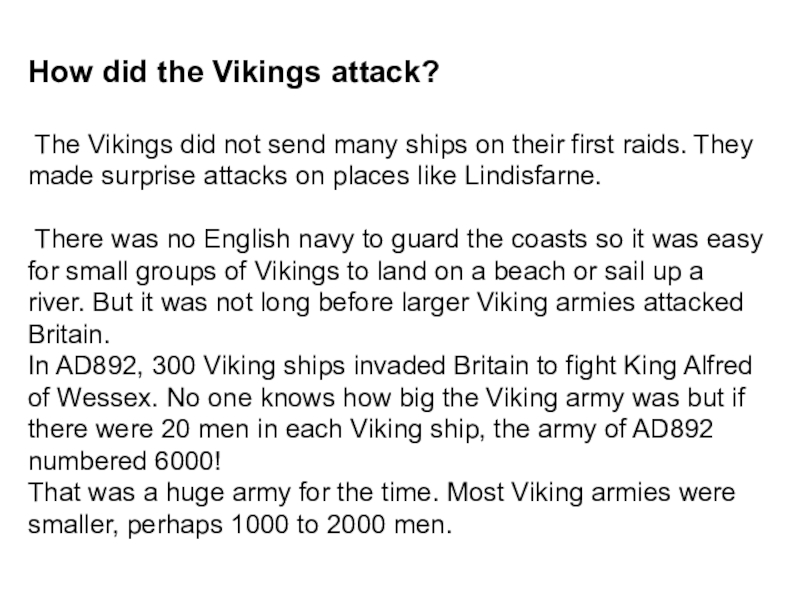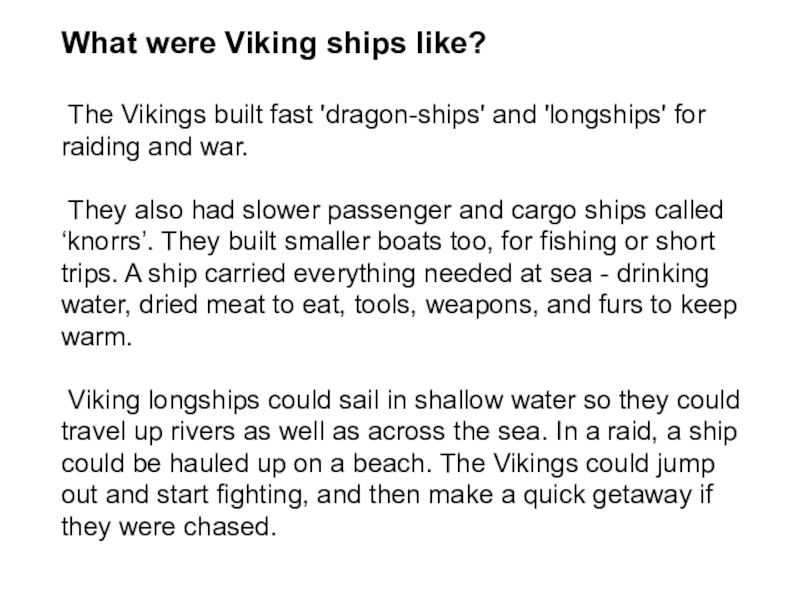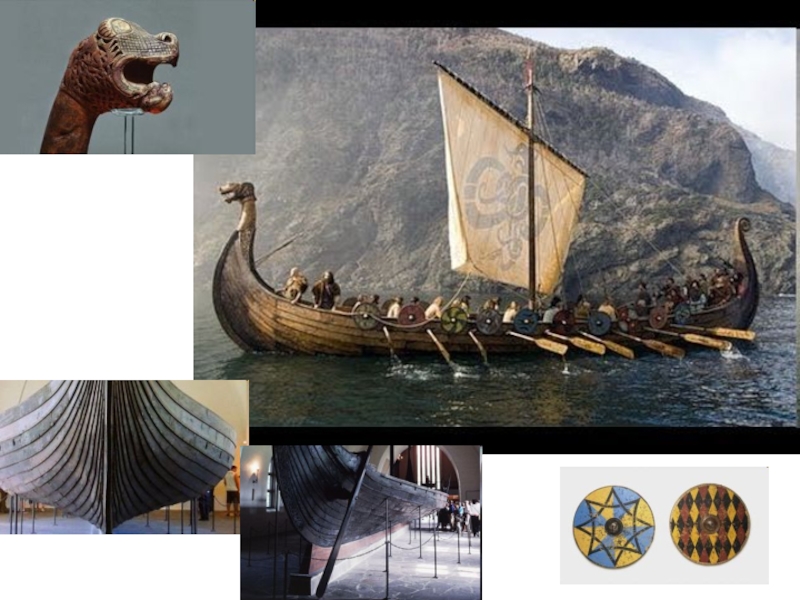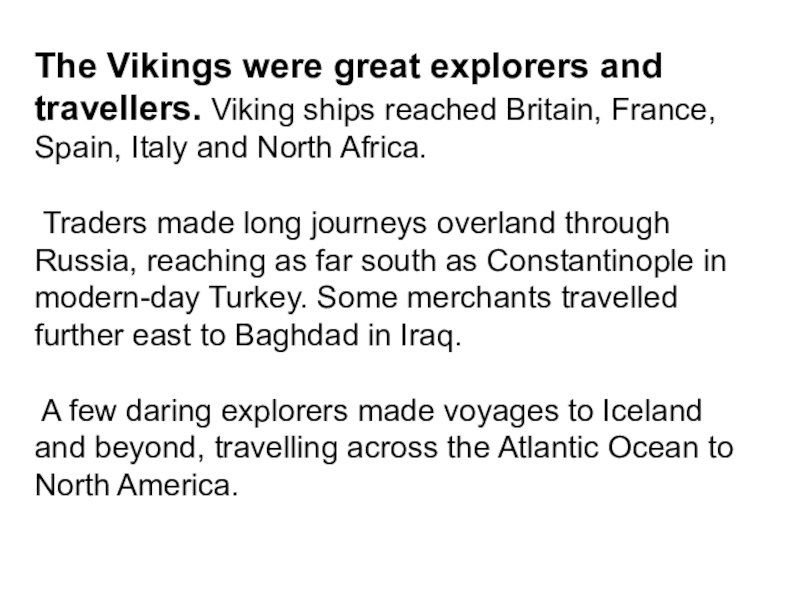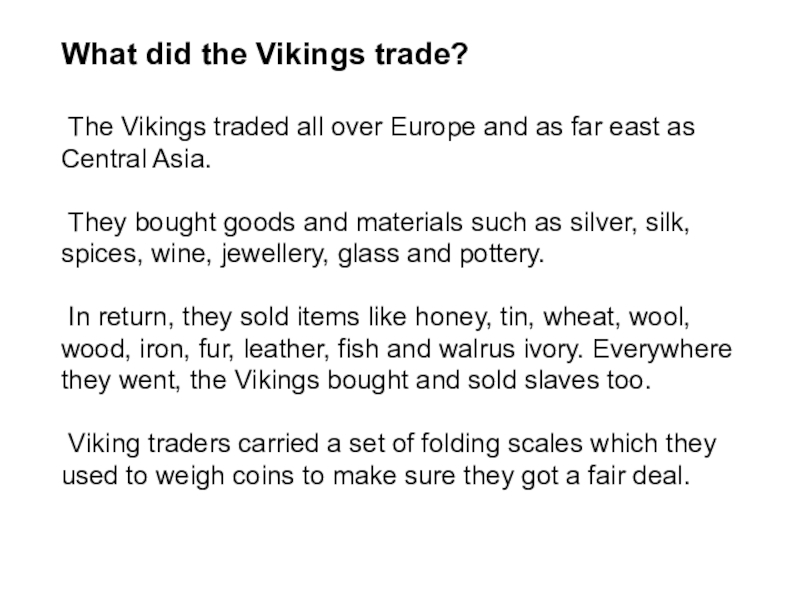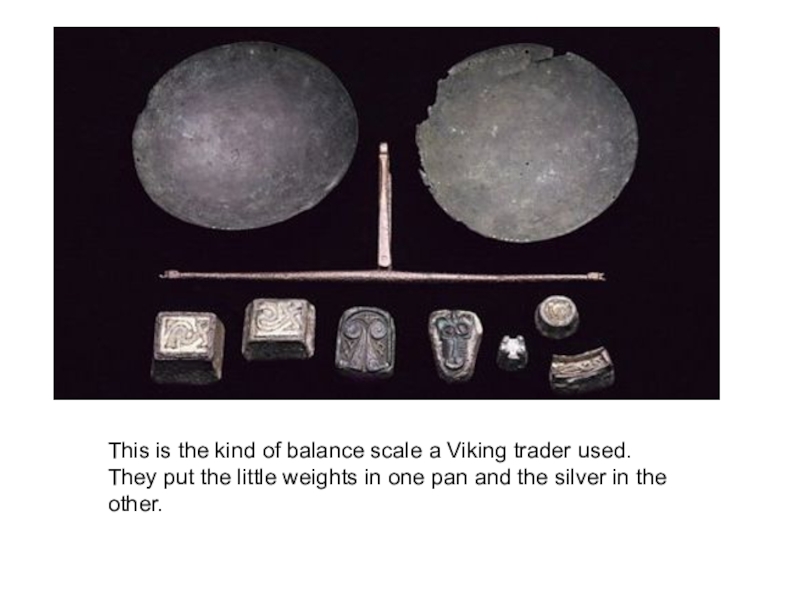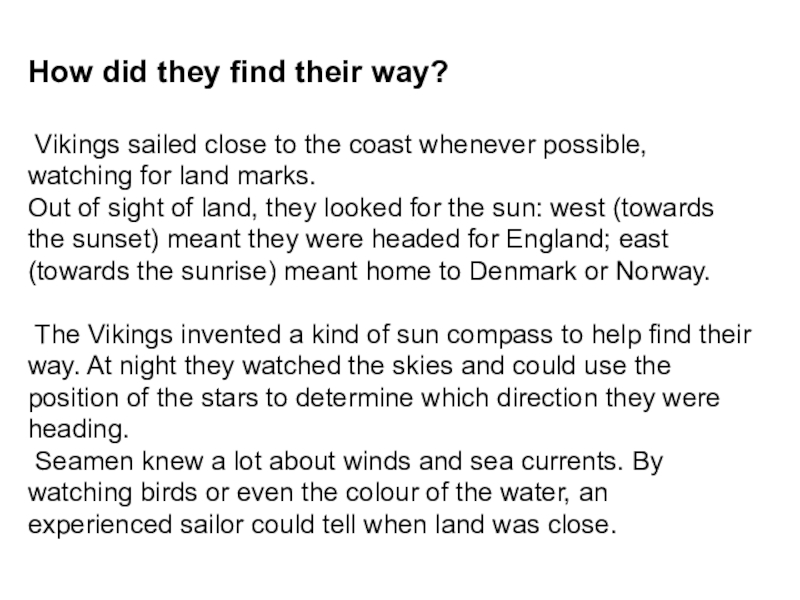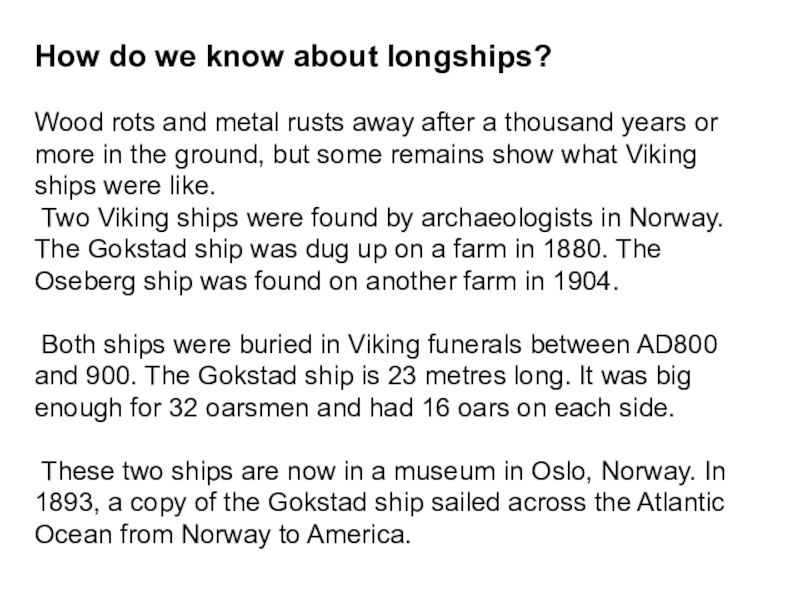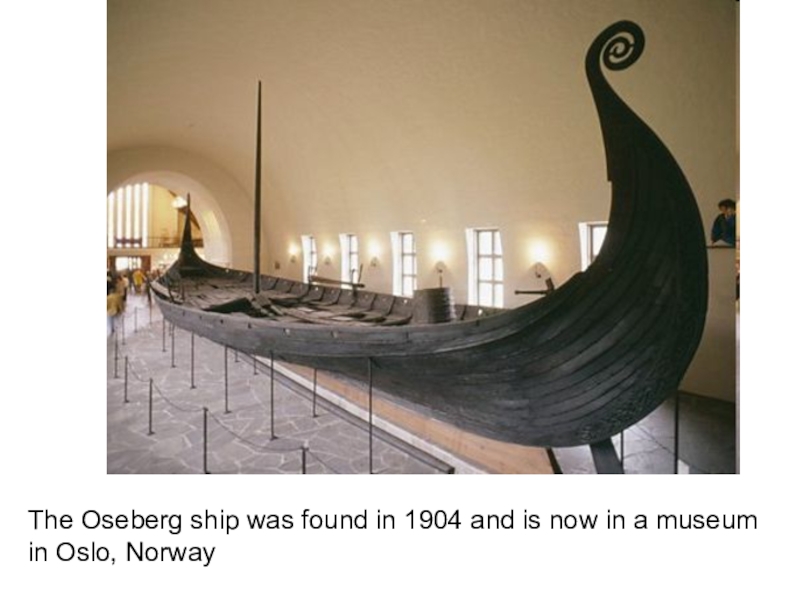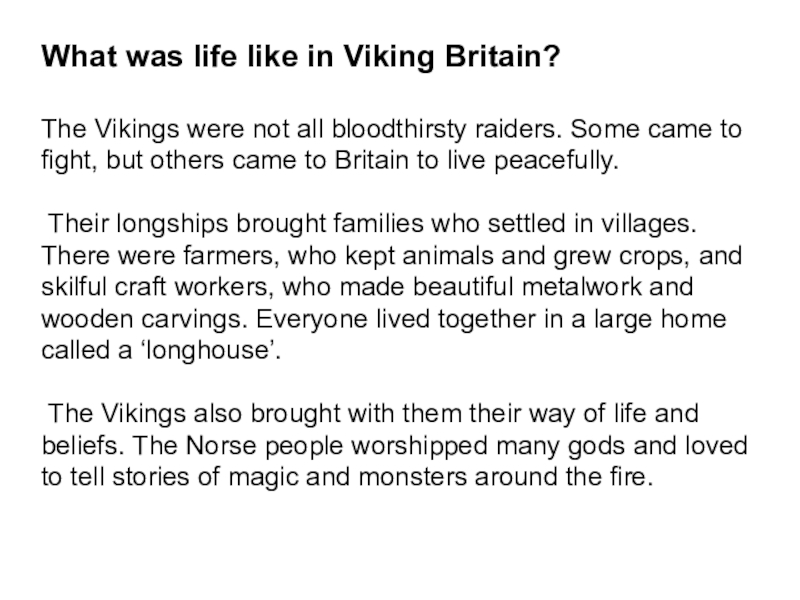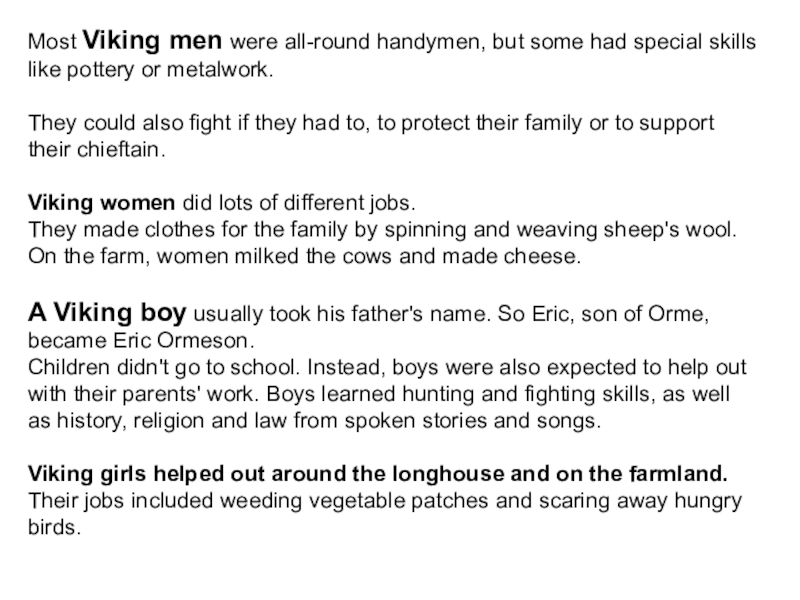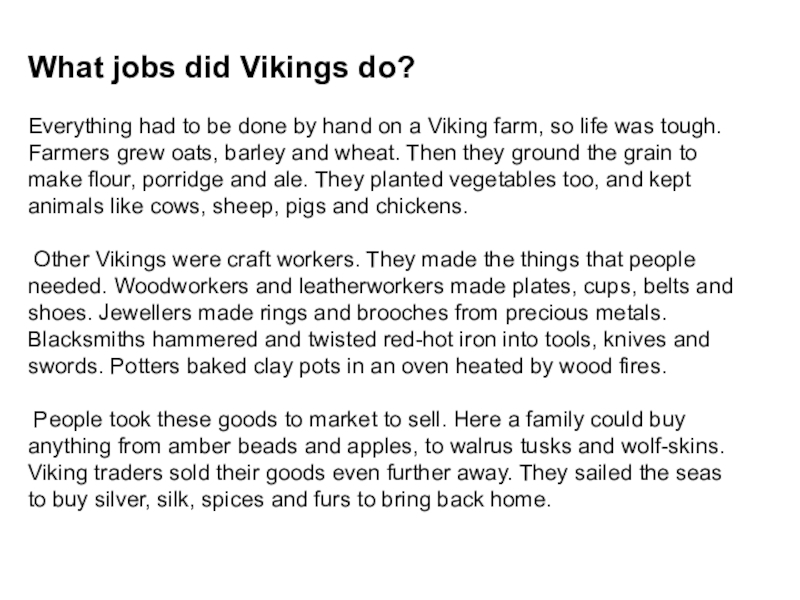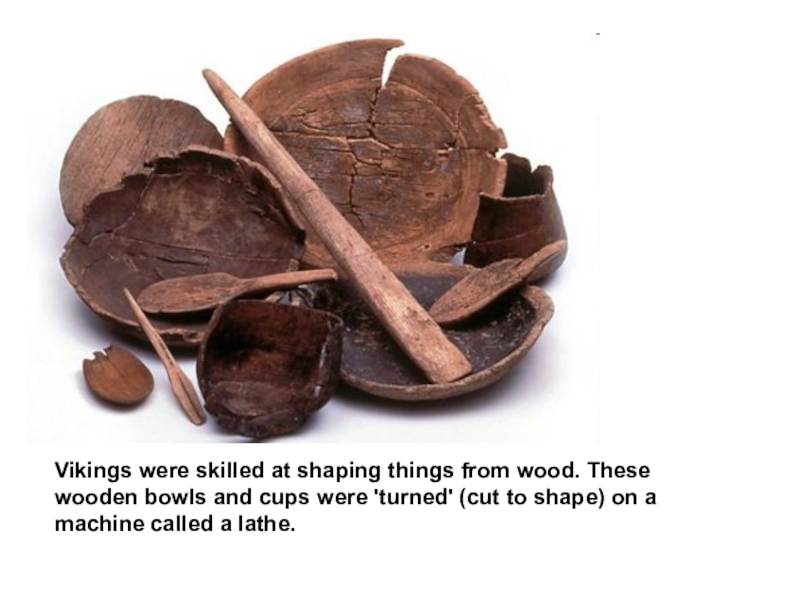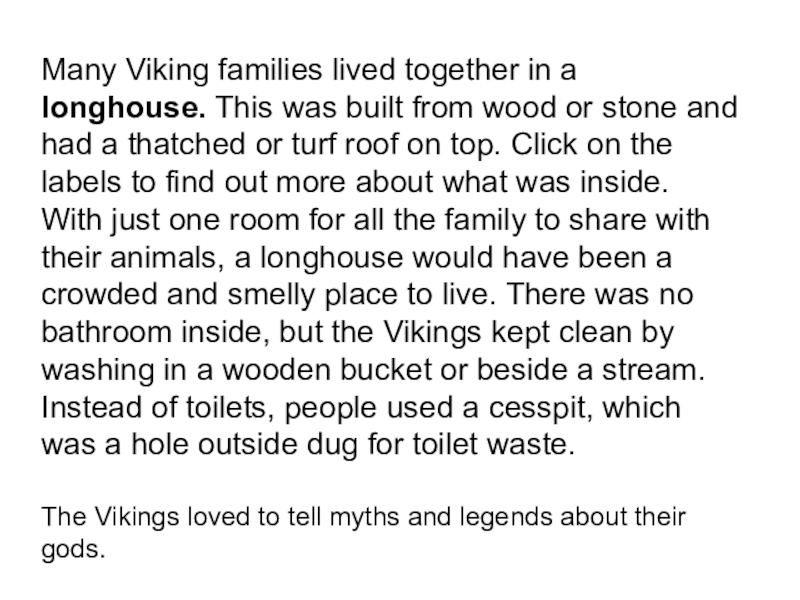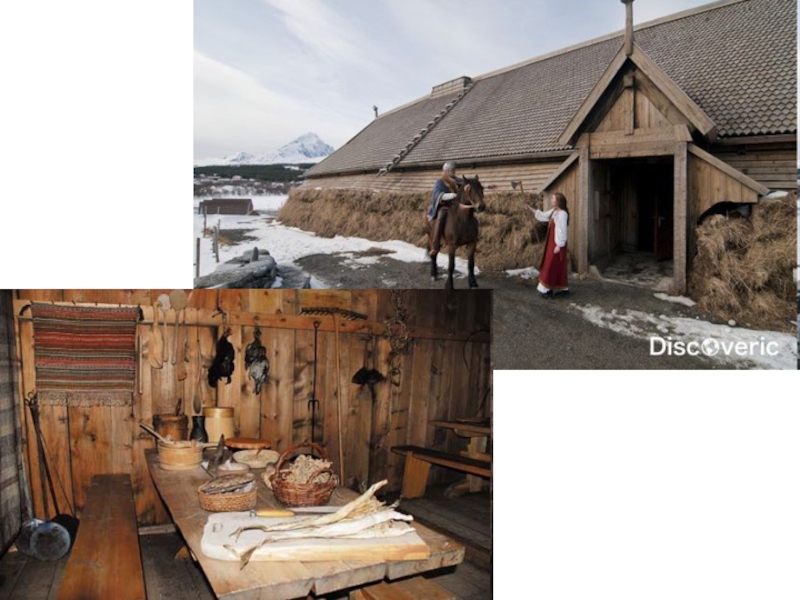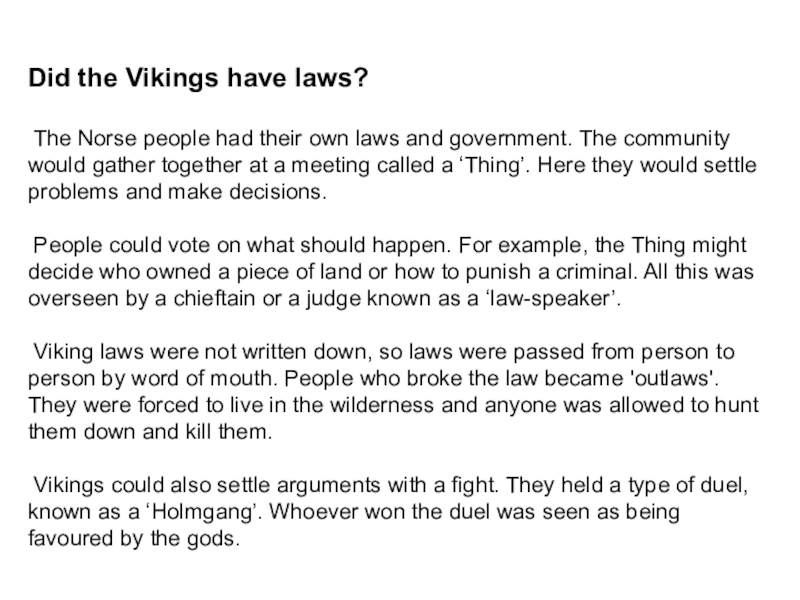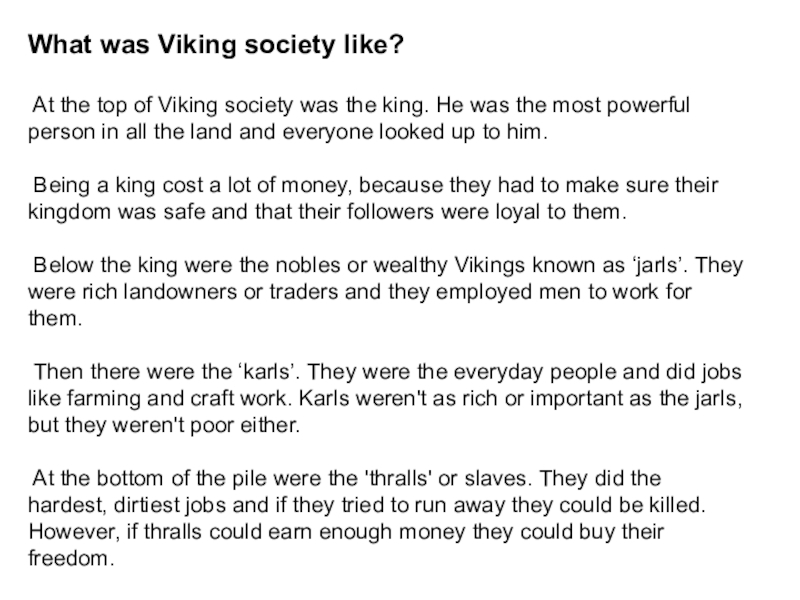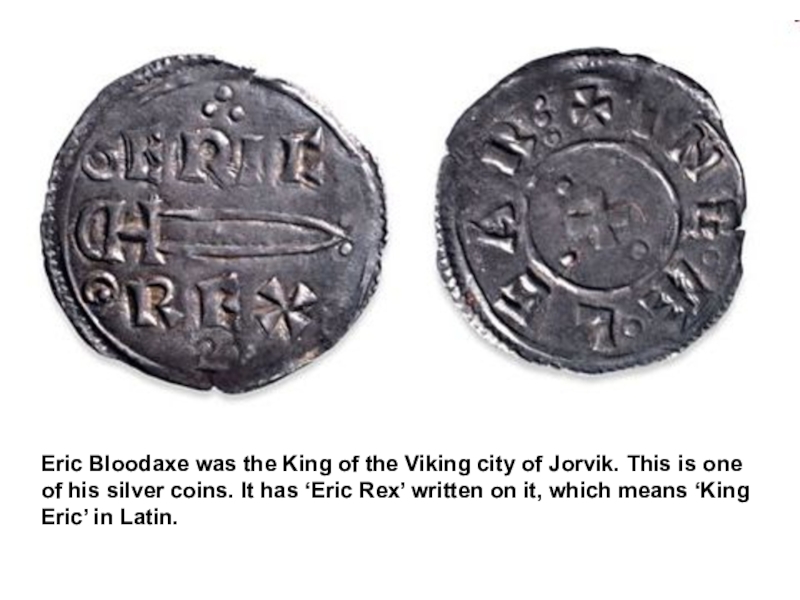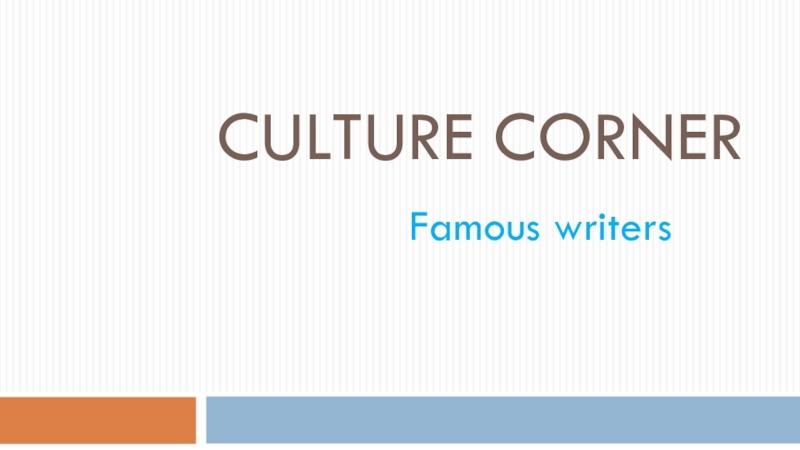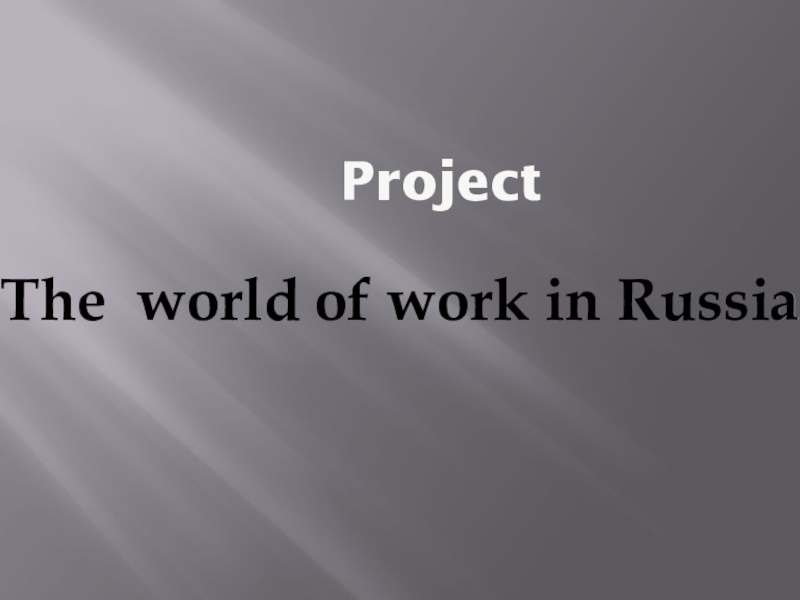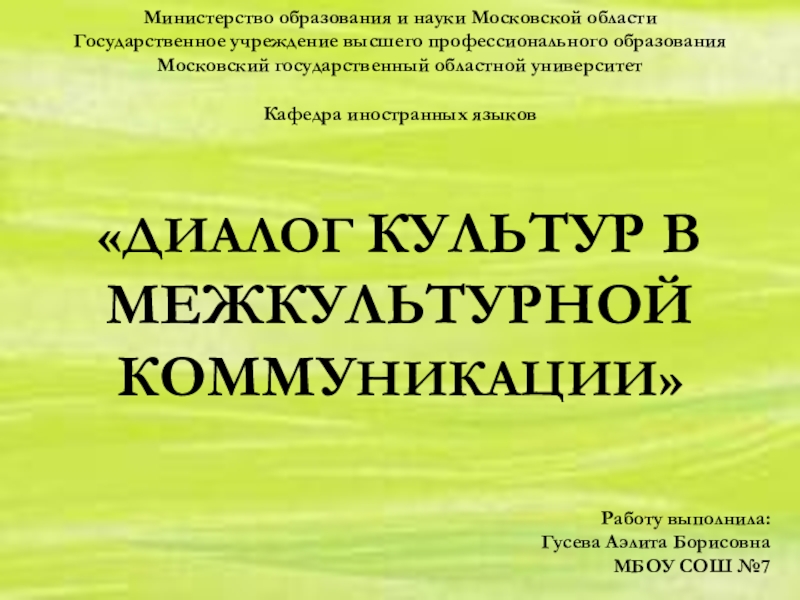about AD700 to 1100. During this period many Vikings left their homelands in Scandinavia and travelled by longboats to other countries, like Britain and Ireland.
When the people of Britain first saw the Viking longboats they came down to the shore to welcome them. However, the Vikings fought the local people, stealing from churches and burning buildings to the ground.
The people of Britain called the invaders 'Danes', but they came from Norway and Sweden as well as Denmark.
- Главная
- Разное
- Образование
- Спорт
- Естествознание
- Природоведение
- Религиоведение
- Французский язык
- Черчение
- Английский язык
- Астрономия
- Алгебра
- Биология
- География
- Геометрия
- Детские презентации
- Информатика
- История
- Литература
- Математика
- Музыка
- МХК
- Немецкий язык
- ОБЖ
- Обществознание
- Окружающий мир
- Педагогика
- Русский язык
- Технология
- Физика
- Философия
- Химия
- Шаблоны, фоны, картинки для презентаций
- Экология
- Экономика
Презентация, доклад по теме Vikings к курсу страноведение
Содержание
- 1. Презентация по теме Vikings к курсу страноведение
- 2. Слайд 2
- 3. Were the Vikings all bad?Viking warriors fought
- 4. Viking raiders from the northIn AD793
- 5. The 'great' Viking invasionIn AD865 an army
- 6. Where did the Vikings settle in Britain?Vikings
- 7. Life in the DanelawThe Danelaw covered
- 8. This photo shows evidence that the Vikings
- 9. How did the Vikings fight?Viking warriors fought
- 10. Chain mail
- 11. How did the Vikings attack? The
- 12. What were Viking ships like? The Vikings
- 13. Слайд 13
- 14. The Vikings were great explorers and travellers.
- 15. What did the Vikings trade? The Vikings
- 16. This is the kind of balance scale
- 17. How did they find their way?
- 18. How do we know about longships?Wood rots
- 19. The Oseberg ship was found in 1904 and is now in a museum in Oslo, Norway
- 20. What was life like in Viking Britain?The
- 21. Most Viking men were all-round handymen, but
- 22. What jobs did Vikings do?Everything had
- 23. Vikings were skilled at shaping things from
- 24. Many Viking families lived together in a
- 25. Слайд 25
- 26. Did the Vikings have laws? The
- 27. What was Viking society like? At
- 28. Eric Bloodaxe was the King of the
Were the Vikings all bad?Viking warriors fought using long swords and axes The name 'Viking' comes from a language called 'Old Norse' and means ‘a pirate raid’. People who went off raiding in ships were said
Слайд 3Were the Vikings all bad?
Viking warriors fought using long swords and
axes
The name 'Viking' comes from a language called 'Old Norse' and means ‘a pirate raid’. People who went off raiding in ships were said to be 'going Viking'. But not all the Vikings were bloodthirsty warriors.
Some came to fight, but others came peacefully, to settle. They were farmers, and kept animals and grew crops. They were skilful at crafting, and made beautiful metalwork and wooden carvings.
Vikings sailed the seas trading goods to buy silver, silks, spices, wine, jewellery, glass and pottery to bring back to their homes.
The name 'Viking' comes from a language called 'Old Norse' and means ‘a pirate raid’. People who went off raiding in ships were said to be 'going Viking'. But not all the Vikings were bloodthirsty warriors.
Some came to fight, but others came peacefully, to settle. They were farmers, and kept animals and grew crops. They were skilful at crafting, and made beautiful metalwork and wooden carvings.
Vikings sailed the seas trading goods to buy silver, silks, spices, wine, jewellery, glass and pottery to bring back to their homes.
Слайд 4
Viking raiders from the north
In AD793 the Vikings famously attacked
a monastery at Lindisfarne in Northumbria, north-east England
The first Viking raid recorded in the Anglo-Saxon Chronicle was around AD787. It was the start of a fierce struggle between the Anglo-Saxons and the Vikings.
The Vikings were pagans, not Christians like most people living in Britain at the time. They did not think twice about raiding a monastery.
Christian monasteries in Britain were easy targets for the Vikings. The monks had no weapons and the buildings were filled with valuable treasures, like gold, jewels and books.
There was food, drink, cattle, clothes and tools too – all very tempting to a Viking raider.
The first Viking raid recorded in the Anglo-Saxon Chronicle was around AD787. It was the start of a fierce struggle between the Anglo-Saxons and the Vikings.
The Vikings were pagans, not Christians like most people living in Britain at the time. They did not think twice about raiding a monastery.
Christian monasteries in Britain were easy targets for the Vikings. The monks had no weapons and the buildings were filled with valuable treasures, like gold, jewels and books.
There was food, drink, cattle, clothes and tools too – all very tempting to a Viking raider.
Слайд 5The 'great' Viking invasion
In AD865 an army of Vikings sailed across
the North Sea. This time they wanted to conquer land rather than just raid it.
Over several years the army battled through northern England, taking control of the Anglo-Saxon kingdoms of Northumbria, East Anglia and most of Mercia.
By AD874, almost all the kingdoms had fallen to the Vikings. All except for Wessex, which was ruled by Alfred the Great. King Alfred beat the Viking army in battle but wasn't able to drive the Vikings out of Britain.
After years of fighting the Vikings and Alfred made a peace agreement. But even after this agreement, fighting went on for many more years. An imaginary dividing line was agreed to run across England, from London in the south towards Chester in the north west.
The Anglo-Saxon lands were to the west and the Viking lands, known as the Danelaw, were roughly to the east.
Over several years the army battled through northern England, taking control of the Anglo-Saxon kingdoms of Northumbria, East Anglia and most of Mercia.
By AD874, almost all the kingdoms had fallen to the Vikings. All except for Wessex, which was ruled by Alfred the Great. King Alfred beat the Viking army in battle but wasn't able to drive the Vikings out of Britain.
After years of fighting the Vikings and Alfred made a peace agreement. But even after this agreement, fighting went on for many more years. An imaginary dividing line was agreed to run across England, from London in the south towards Chester in the north west.
The Anglo-Saxon lands were to the west and the Viking lands, known as the Danelaw, were roughly to the east.
Слайд 6Where did the Vikings settle in Britain?
Vikings travelled from Scandinavia to
Britain. They mostly settled in the Danelaw, to the north and east of England. Some Norwegian Vikings or 'Norse' sailed to Scotland. They made settlements in the north, and on the Shetland and Orkney Islands. Vikings also settled on the Isle of Man and often raided Wales, but few made homes there. In Ireland, the Vikings founded the city of Dublin.
Слайд 7
Life in the Danelaw
The Danelaw covered an area east of
their line joining London and Chester. Everything to the east belonged to the Vikings.
There were three main areas where Vikings lived - Northumbria (which included modern-day Yorkshire), East Anglia, and the Five Boroughs. A borough was a town and the five towns were Leicester, Nottingham, Derby, Stamford and Lincoln.
Viking families came to settle on these lands. Good farmland was scarce in the Vikings' own countries, and they were looking for a better life.
The most important city in the Danelaw was the city of York, or ‘Jorvik’ (pronounced 'your-vick'), as the Vikings knew it. Over 10,000 people lived there and it was an important place to trade goods.
Many towns and cities in Britain that were founded by the Vikings can still be spotted today. Places that end in -by, -thorpe or -ay were almost certainly Viking towns.
There were three main areas where Vikings lived - Northumbria (which included modern-day Yorkshire), East Anglia, and the Five Boroughs. A borough was a town and the five towns were Leicester, Nottingham, Derby, Stamford and Lincoln.
Viking families came to settle on these lands. Good farmland was scarce in the Vikings' own countries, and they were looking for a better life.
The most important city in the Danelaw was the city of York, or ‘Jorvik’ (pronounced 'your-vick'), as the Vikings knew it. Over 10,000 people lived there and it was an important place to trade goods.
Many towns and cities in Britain that were founded by the Vikings can still be spotted today. Places that end in -by, -thorpe or -ay were almost certainly Viking towns.
Слайд 8This photo shows evidence that the Vikings of Jorvik went horse
riding and hunting. These are stirrups, weapon points and a horseshoe.
Слайд 9How did the Vikings fight?
Viking warriors fought using long swords and
axes. A good sword was handed down from father to son, but Vikings also buried weapons with their owner when he died.
Vikings did not wear much armour. Some chieftains wore chain mail coats, but most relied on a round wooden shield for protection.
Some Viking warriors went into battle wearing wolf or bear skins. These warriors were called ‘berserkers’ because they went ‘berserk’ (out of control) and charged fearlessly into battle. Berserkers believed that Odin, the god of war, gave them superhuman powers and that they didn't need to wear battle armour for protection.
Vikings did not wear much armour. Some chieftains wore chain mail coats, but most relied on a round wooden shield for protection.
Some Viking warriors went into battle wearing wolf or bear skins. These warriors were called ‘berserkers’ because they went ‘berserk’ (out of control) and charged fearlessly into battle. Berserkers believed that Odin, the god of war, gave them superhuman powers and that they didn't need to wear battle armour for protection.
Слайд 11
How did the Vikings attack?
The Vikings did not send
many ships on their first raids. They made surprise attacks on places like Lindisfarne.
There was no English navy to guard the coasts so it was easy for small groups of Vikings to land on a beach or sail up a river. But it was not long before larger Viking armies attacked Britain.
In AD892, 300 Viking ships invaded Britain to fight King Alfred of Wessex. No one knows how big the Viking army was but if there were 20 men in each Viking ship, the army of AD892 numbered 6000!
That was a huge army for the time. Most Viking armies were smaller, perhaps 1000 to 2000 men.
There was no English navy to guard the coasts so it was easy for small groups of Vikings to land on a beach or sail up a river. But it was not long before larger Viking armies attacked Britain.
In AD892, 300 Viking ships invaded Britain to fight King Alfred of Wessex. No one knows how big the Viking army was but if there were 20 men in each Viking ship, the army of AD892 numbered 6000!
That was a huge army for the time. Most Viking armies were smaller, perhaps 1000 to 2000 men.
Слайд 12What were Viking ships like?
The Vikings built fast 'dragon-ships' and
'longships' for raiding and war.
They also had slower passenger and cargo ships called ‘knorrs’. They built smaller boats too, for fishing or short trips. A ship carried everything needed at sea - drinking water, dried meat to eat, tools, weapons, and furs to keep warm.
Viking longships could sail in shallow water so they could travel up rivers as well as across the sea. In a raid, a ship could be hauled up on a beach. The Vikings could jump out and start fighting, and then make a quick getaway if they were chased.
They also had slower passenger and cargo ships called ‘knorrs’. They built smaller boats too, for fishing or short trips. A ship carried everything needed at sea - drinking water, dried meat to eat, tools, weapons, and furs to keep warm.
Viking longships could sail in shallow water so they could travel up rivers as well as across the sea. In a raid, a ship could be hauled up on a beach. The Vikings could jump out and start fighting, and then make a quick getaway if they were chased.
Слайд 14The Vikings were great explorers and travellers. Viking ships reached Britain,
France, Spain, Italy and North Africa.
Traders made long journeys overland through Russia, reaching as far south as Constantinople in modern-day Turkey. Some merchants travelled further east to Baghdad in Iraq.
A few daring explorers made voyages to Iceland and beyond, travelling across the Atlantic Ocean to North America.
Traders made long journeys overland through Russia, reaching as far south as Constantinople in modern-day Turkey. Some merchants travelled further east to Baghdad in Iraq.
A few daring explorers made voyages to Iceland and beyond, travelling across the Atlantic Ocean to North America.
Слайд 15What did the Vikings trade?
The Vikings traded all over Europe
and as far east as Central Asia.
They bought goods and materials such as silver, silk, spices, wine, jewellery, glass and pottery.
In return, they sold items like honey, tin, wheat, wool, wood, iron, fur, leather, fish and walrus ivory. Everywhere they went, the Vikings bought and sold slaves too.
Viking traders carried a set of folding scales which they used to weigh coins to make sure they got a fair deal.
They bought goods and materials such as silver, silk, spices, wine, jewellery, glass and pottery.
In return, they sold items like honey, tin, wheat, wool, wood, iron, fur, leather, fish and walrus ivory. Everywhere they went, the Vikings bought and sold slaves too.
Viking traders carried a set of folding scales which they used to weigh coins to make sure they got a fair deal.
Слайд 16This is the kind of balance scale a Viking trader used.
They put the little weights in one pan and the silver in the other.
Слайд 17
How did they find their way?
Vikings sailed close to
the coast whenever possible, watching for land marks.
Out of sight of land, they looked for the sun: west (towards the sunset) meant they were headed for England; east (towards the sunrise) meant home to Denmark or Norway.
The Vikings invented a kind of sun compass to help find their way. At night they watched the skies and could use the position of the stars to determine which direction they were heading.
Seamen knew a lot about winds and sea currents. By watching birds or even the colour of the water, an experienced sailor could tell when land was close.
Out of sight of land, they looked for the sun: west (towards the sunset) meant they were headed for England; east (towards the sunrise) meant home to Denmark or Norway.
The Vikings invented a kind of sun compass to help find their way. At night they watched the skies and could use the position of the stars to determine which direction they were heading.
Seamen knew a lot about winds and sea currents. By watching birds or even the colour of the water, an experienced sailor could tell when land was close.
Слайд 18How do we know about longships?
Wood rots and metal rusts away
after a thousand years or more in the ground, but some remains show what Viking ships were like.
Two Viking ships were found by archaeologists in Norway. The Gokstad ship was dug up on a farm in 1880. The Oseberg ship was found on another farm in 1904.
Both ships were buried in Viking funerals between AD800 and 900. The Gokstad ship is 23 metres long. It was big enough for 32 oarsmen and had 16 oars on each side.
These two ships are now in a museum in Oslo, Norway. In 1893, a copy of the Gokstad ship sailed across the Atlantic Ocean from Norway to America.
Two Viking ships were found by archaeologists in Norway. The Gokstad ship was dug up on a farm in 1880. The Oseberg ship was found on another farm in 1904.
Both ships were buried in Viking funerals between AD800 and 900. The Gokstad ship is 23 metres long. It was big enough for 32 oarsmen and had 16 oars on each side.
These two ships are now in a museum in Oslo, Norway. In 1893, a copy of the Gokstad ship sailed across the Atlantic Ocean from Norway to America.
Слайд 20What was life like in Viking Britain?
The Vikings were not all
bloodthirsty raiders. Some came to fight, but others came to Britain to live peacefully.
Their longships brought families who settled in villages. There were farmers, who kept animals and grew crops, and skilful craft workers, who made beautiful metalwork and wooden carvings. Everyone lived together in a large home called a ‘longhouse’.
The Vikings also brought with them their way of life and beliefs. The Norse people worshipped many gods and loved to tell stories of magic and monsters around the fire.
Their longships brought families who settled in villages. There were farmers, who kept animals and grew crops, and skilful craft workers, who made beautiful metalwork and wooden carvings. Everyone lived together in a large home called a ‘longhouse’.
The Vikings also brought with them their way of life and beliefs. The Norse people worshipped many gods and loved to tell stories of magic and monsters around the fire.
Слайд 21Most Viking men were all-round handymen, but some had special skills
like pottery or metalwork.
They could also fight if they had to, to protect their family or to support their chieftain.
Viking women did lots of different jobs.
They made clothes for the family by spinning and weaving sheep's wool. On the farm, women milked the cows and made cheese.
A Viking boy usually took his father's name. So Eric, son of Orme, became Eric Ormeson.
Children didn't go to school. Instead, boys were also expected to help out with their parents' work. Boys learned hunting and fighting skills, as well as history, religion and law from spoken stories and songs.
Viking girls helped out around the longhouse and on the farmland.
Their jobs included weeding vegetable patches and scaring away hungry birds.
They could also fight if they had to, to protect their family or to support their chieftain.
Viking women did lots of different jobs.
They made clothes for the family by spinning and weaving sheep's wool. On the farm, women milked the cows and made cheese.
A Viking boy usually took his father's name. So Eric, son of Orme, became Eric Ormeson.
Children didn't go to school. Instead, boys were also expected to help out with their parents' work. Boys learned hunting and fighting skills, as well as history, religion and law from spoken stories and songs.
Viking girls helped out around the longhouse and on the farmland.
Their jobs included weeding vegetable patches and scaring away hungry birds.
Слайд 22
What jobs did Vikings do?
Everything had to be done by
hand on a Viking farm, so life was tough. Farmers grew oats, barley and wheat. Then they ground the grain to make flour, porridge and ale. They planted vegetables too, and kept animals like cows, sheep, pigs and chickens.
Other Vikings were craft workers. They made the things that people needed. Woodworkers and leatherworkers made plates, cups, belts and shoes. Jewellers made rings and brooches from precious metals. Blacksmiths hammered and twisted red-hot iron into tools, knives and swords. Potters baked clay pots in an oven heated by wood fires.
People took these goods to market to sell. Here a family could buy anything from amber beads and apples, to walrus tusks and wolf-skins. Viking traders sold their goods even further away. They sailed the seas to buy silver, silk, spices and furs to bring back home.
Other Vikings were craft workers. They made the things that people needed. Woodworkers and leatherworkers made plates, cups, belts and shoes. Jewellers made rings and brooches from precious metals. Blacksmiths hammered and twisted red-hot iron into tools, knives and swords. Potters baked clay pots in an oven heated by wood fires.
People took these goods to market to sell. Here a family could buy anything from amber beads and apples, to walrus tusks and wolf-skins. Viking traders sold their goods even further away. They sailed the seas to buy silver, silk, spices and furs to bring back home.
Слайд 23Vikings were skilled at shaping things from wood. These wooden bowls
and cups were 'turned' (cut to shape) on a machine called a lathe.
Слайд 24Many Viking families lived together in a longhouse. This was built
from wood or stone and had a thatched or turf roof on top. Click on the labels to find out more about what was inside.
With just one room for all the family to share with their animals, a longhouse would have been a crowded and smelly place to live. There was no bathroom inside, but the Vikings kept clean by washing in a wooden bucket or beside a stream. Instead of toilets, people used a cesspit, which was a hole outside dug for toilet waste.
The Vikings loved to tell myths and legends about their gods.
With just one room for all the family to share with their animals, a longhouse would have been a crowded and smelly place to live. There was no bathroom inside, but the Vikings kept clean by washing in a wooden bucket or beside a stream. Instead of toilets, people used a cesspit, which was a hole outside dug for toilet waste.
The Vikings loved to tell myths and legends about their gods.
Слайд 26
Did the Vikings have laws?
The Norse people had their
own laws and government. The community would gather together at a meeting called a ‘Thing’. Here they would settle problems and make decisions.
People could vote on what should happen. For example, the Thing might decide who owned a piece of land or how to punish a criminal. All this was overseen by a chieftain or a judge known as a ‘law-speaker’.
Viking laws were not written down, so laws were passed from person to person by word of mouth. People who broke the law became 'outlaws'. They were forced to live in the wilderness and anyone was allowed to hunt them down and kill them.
Vikings could also settle arguments with a fight. They held a type of duel, known as a ‘Holmgang’. Whoever won the duel was seen as being favoured by the gods.
People could vote on what should happen. For example, the Thing might decide who owned a piece of land or how to punish a criminal. All this was overseen by a chieftain or a judge known as a ‘law-speaker’.
Viking laws were not written down, so laws were passed from person to person by word of mouth. People who broke the law became 'outlaws'. They were forced to live in the wilderness and anyone was allowed to hunt them down and kill them.
Vikings could also settle arguments with a fight. They held a type of duel, known as a ‘Holmgang’. Whoever won the duel was seen as being favoured by the gods.
Слайд 27
What was Viking society like?
At the top of Viking
society was the king. He was the most powerful person in all the land and everyone looked up to him.
Being a king cost a lot of money, because they had to make sure their kingdom was safe and that their followers were loyal to them.
Below the king were the nobles or wealthy Vikings known as ‘jarls’. They were rich landowners or traders and they employed men to work for them.
Then there were the ‘karls’. They were the everyday people and did jobs like farming and craft work. Karls weren't as rich or important as the jarls, but they weren't poor either.
At the bottom of the pile were the 'thralls' or slaves. They did the hardest, dirtiest jobs and if they tried to run away they could be killed. However, if thralls could earn enough money they could buy their freedom.
Being a king cost a lot of money, because they had to make sure their kingdom was safe and that their followers were loyal to them.
Below the king were the nobles or wealthy Vikings known as ‘jarls’. They were rich landowners or traders and they employed men to work for them.
Then there were the ‘karls’. They were the everyday people and did jobs like farming and craft work. Karls weren't as rich or important as the jarls, but they weren't poor either.
At the bottom of the pile were the 'thralls' or slaves. They did the hardest, dirtiest jobs and if they tried to run away they could be killed. However, if thralls could earn enough money they could buy their freedom.
Слайд 28Eric Bloodaxe was the King of the Viking city of Jorvik.
This is one of his silver coins. It has ‘Eric Rex’ written on it, which means ‘King Eric’ in Latin.
